What Type Of Animal Is A Wren
| Wren | |
|---|---|
 | |
| Marsh wren (Cistothorus palustris) | |
| Eurasian wren recorded in Speyside, Scotland | |
| Scientific nomenclature | |
| Kingdom: | Animalia |
| Phylum: | Chordata |
| Form: | Aves |
| Club: | Passeriformes |
| Superfamily: | Certhioidea |
| Family: | Troglodytidae Swainson, 1832 |
| Genera and species | |
| See text | |
Wrens are a family of chocolate-brown passerine birds in the predominantly New Earth family Troglodytidae. The family includes 88 species divided into 19 genera. Only the Eurasian wren occurs in the Old Globe, where, in Anglophone regions, it is commonly known simply as the "wren", equally it is the originator of the name. The name wren has been applied to other, unrelated birds, particularly the New Zealand wrens (Acanthisittidae) and the Australian wrens (Maluridae).
Nearly wrens are visually inconspicuous (being, in fact, the shortest bird in England)[1] though they accept loud and oft circuitous songs. Exceptions include the relatively big members of the genus Campylorhynchus, which tin be quite assuming in their behavior. Wrens take brusk wings that are barred in most species, and they often concur their tails upright. Wrens are primarily insectivorous, eating insects, spiders, and other minor invertebrates, but many species as well eat vegetable matter and some eat small-scale frogs and lizards.[ii]
Etymology and usage [edit]
The English language name "wren" derives from Middle English: wrenne and Old English: wrænna , attested (as wernnaa ) very early, in an eighth-century gloss. It is cognate to Old High German: wrendo, wrendilo , and Icelandic: rindill (the latter two including an additional diminutive -ilan suffix). The Icelandic name is attested in Former Icelandic (Eddaic) equally rindilþvari . This points to a Common Germanic proper noun wrandjan- , just the farther etymology of the name is unknown.[3]
The wren was also known every bit the kuningilin ('kinglet') in Old High German, a proper name associated with the fable of the election of the "king of birds". The bird that could fly to the highest distance would be made king. The eagle outflew all other birds, only he was beaten by a small bird that had subconscious in his plumage. This fable was already known to Aristotle (Historia Animalium ix.11)[iv] and Pliny (Natural History 10.95),[5] [6] and was taken upward by medieval authors such as Johann Geiler von Kaisersberg, only it most likely originally concerned kinglets ( Regulus ) and was evidently motivated by the yellow "crown" sported by these birds (a bespeak noted already by Ludwig Uhland).[vii] The confusion stemmed in part from the similarity and consequent interchangeability of the Ancient Greek words for the wren ( βασιλεύς basileus , 'male monarch')[eight] and the crest ( βασιλίσκος basiliskos , 'kinglet'),[9] [10] and the legend's reference to the "smallest of birds" condign king likely led the title to be transferred to the as tiny wren.[7] [11] In modern German, the name of the bird is Zaunkönig ('rex of the debate (or hedge)') and in Dutch, the proper name is winterkoning ('king of wintertime').
The family unit name Troglodytidae is derived from troglodyte, which ways 'cave-dweller'.[12] Wrens get their scientific name from the tendency of some species to forage in night crevices.
The name "wren" is also ascribed to other families of passerine birds throughout the globe. In Europe, kinglets are unremarkably known every bit "wrens", with the common firecrest and goldcrest known as the "fire-crested wren" and "golden-crested wren", respectively.
The 27 Australasian "wren" species in the family unit Maluridae are unrelated, as are the New Zealand wrens in the family Acanthisittidae, the antbirds in the family Thamnophilidae, and the Old Earth babblers of the family Timaliidae.
Clarification [edit]
Wrens are medium-small to very small-scale birds. The Eurasian wren is among the smallest birds in its range, while the smaller species from the Americas are amongst the smallest passerines in that part of the world. They range in size from the white-bellied wren, which averages under 10 cm (three.9 in) and nine g (0.32 oz), to the giant wren, which averages about 22 cm (8.seven in) and weighs almost 50 yard (i.8 oz). The dominating colors of their plume are generally drab, composed of grey, brown, blackness, and white, and virtually species show some barring, particularly on the tail or wings. No sexual dimorphism is seen in the plume of wrens, and little difference exists between immature birds and adults.[two] All take fairly long, straight to marginally decurved (downward-curving) bills.[2]
Wrens have loud and oft circuitous songs, sometimes given in duet by a pair. The songs of members of the genera Cyphorhinus and Microcerculus have been considered peculiarly pleasant to the human ear, leading to mutual names such as vocal wren, musician wren, flutist wren, and southern nightingale-wren.[two]
Distribution and habitat [edit]

Wrens are principally a New World family, distributed from Alaska and Canada to southern Argentina, with the greatest species richness in the Neotropics. Every bit suggested by its name, the Eurasian wren is the only species of wren found outside the Americas, as restricted to Europe, Asia, and northern Africa (it was formerly considered conspecific with the winter wren and Pacific wren of Due north America). The insular species include the Clarión wren and Socorro wren from the Revillagigedo Islands in the Pacific Ocean, and Cobb's wren in the Falkland Islands, but few Caribbean area islands have a species of wren, with only the southern house wren in the Lesser Antilles, the Cozumel wren of Cozumel Island, and the highly restricted Zapata wren in a single swamp in Cuba.
The various species occur in a wide range of habitats, ranging from dry, sparsely wooded land to rainforests. Most species are mainly found at depression levels, but members of the genus Campylorhynchus are ofttimes found higher, and the ii members of Odontorchilus are restricted to the woods canopy.[2] A few species, notably the Eurasian wren and the house wren, are oft associated with humans. Nearly species are resident, remaining in Central and Due south America all yr round, merely the few species found in temperate regions of the Northern Hemisphere are partially migratory, spending the winter further southward.
Behavior and ecology [edit]
Wrens vary from highly secretive species such as those found in the genus Microcerculus to the highly conspicuous genus Campylorhynchus, the members of which frequently sing from exposed perches. The family as a whole exhibits a peachy deal of variation in their behavior. Temperate species more often than not occur in pairs, merely some tropical species may occur in parties of upward to xx birds.[2]
Wrens build dome-shaped nests, and may exist either monogamous or polygamous, depending on species.[13]
Though little is known about the feeding habits of many of the Neotropical species, wrens are considered primarily insectivorous, eating insects, spiders, and other pocket-sized arthropods.[ii] Many species also take vegetable thing such as seeds and berries, and some (primarily the larger species) accept small frogs and lizards. The Eurasian wren has been recorded wading into shallow water to take hold of small fish and tadpoles; Sumichrast's wren and the Zapata wren take snails; and the giant wren and marsh wren have been recorded attacking and eating bird eggs (in the latter species, even eggs of conspecifics).[2] A local Spanish proper name for the giant wren and bicolored wren is chupahuevo ('egg-sucker'), but whether the latter actually eats eggs is unclear.[2] The plain wren and northern house wren sometimes destroy bird eggs, and the rufous-and-white wren has been recorded killing nestlings, only this is apparently to eliminate potential food competitors rather than to feed on the eggs or nestlings.[2] Several species of Neotropical wrens sometimes participate in mixed-species flocks or follow army ants, and the Eurasian wren may follow badgers to catch prey items disturbed past them.[ii]
Taxonomy and systematics [edit]
| Relatives of the wrens in the superfamily Certhioidea.[14] |
Revised post-obit Martínez Gómez et al. (2005) and Isle of mann et al. (2006), the taxonomy of some groups is highly complex, and hereafter species-level splits are likely. Additionally, undescribed taxa are known to exist. The blackness-capped donacobius is an enigmatic species traditionally placed with the wrens more for lack of a more apparent alternative than as a result of thorough study. Information technology was recently determined to be most likely closer to certain warblers, possibly the newly established Megaluridae, and might plant a monotypic family unit.[xv]
Family Troglodytidae
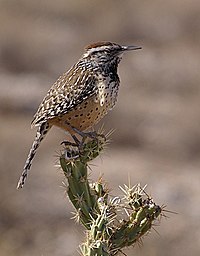
- Genus Campylorhynchus
- White-headed wren (Campylorhynchus albobrunneus)
- Ring-backed wren (Campylorhynchus zonatus)
- Greyness-barred wren (Campylorhynchus megalopterus)
- Stripe-backed wren (Campylorhynchus nuchalis)
- Fasciated wren (Campylorhynchus fasciatus)
- Giant wren (Campylorhynchus chiapensis)
- Bicolored wren (Campylorhynchus griseus)
- Veracruz wren (Campylorhynchus rufinucha)
- Sclater'south wren (Campylorhynchus humilis)
- Rufous-backed wren (Campylorhynchus capistratus)
- Spotted wren (Campylorhynchus gularis)
- Yucatan wren (Campylorhynchus yucatanicus)
- Boucard's wren (Campylorhynchus jocosus)
- Cactus wren (Campylorhynchus brunneicapillus)
- Thrush-similar wren (Campylorhynchus turdinus)
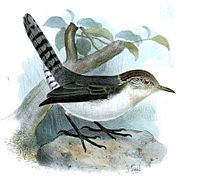
- Genus Odontorchilus
- Grayness-mantled wren (Odontorchilus branickii)
- Tooth-billed wren (Odontorchilus cinereus)

- Genus Salpinctes
- Rock wren (Salpinctes obsoletus)

- Genus Catherpes
- Canyon wren (Catherpes mexicanus)
- Genus Hylorchilus
- Sumichrast's wren (Hylorchilus sumichrasti)
- Nava'due south wren (Hylorchilus navai)
- Genus Cinnycerthia
- Rufous wren (Cinnycerthia unirufa)
- Sepia-brownish wren (Cinnycerthia olivascens)
- Peruvian wren (Cinnycerthia peruana)
- Fulvous wren (Cinnycerthia fulva)
- Genus Cistothorus
- Sedge wren (Cistothorus stellaris)
- Mérida wren or paramo wren (Cistothorus meridae)
- Apolinar's wren (Cistothorus apolinari)
- Grass wren (Cistothorus platensis)
- Marsh wren (Cistothorus palustris)

- Genus Thryomanes
- Bewick'southward wren (Thryomanes bewickii)
- Genus Ferminia
- Zapata wren (Ferminia cerverai)
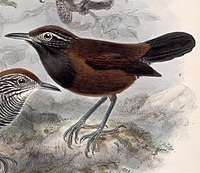
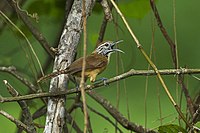
- Genus Pheugopedius (formerly included in Thryothorus)
- Black-throated wren (Pheugopedius atrogularis)
- Sooty-headed wren (Pheugopedius spadix)
- Black-bellied wren (Pheugopedius fasciatoventris)
- Plain-tailed wren (Pheugopedius euophrys)
- Inca wren (Pheugopedius eisenmanni)
- Moustached wren (Pheugopedius genibarbis)
- Whiskered wren (Pheugopedius mystacalis)
- Coraya wren (Pheugopedius coraya)
- Happy wren (Pheugopedius felix)
- Spot-breasted wren (Pheugopedius maculipectus)
- Rufous-breasted wren (Pheugopedius rutilus)
- Speckle-breasted wren (Pheugopedius sclateri)
- Genus Thryophilus (formerly included in Thryothorus)
- Banded wren (Thryophilus pleurostictus)
- Rufous-and-white wren (Thryophilus rufalbus)
- Antioquia wren (Thryophilus sernai)
- Niceforo's wren (Thryophilus nicefori)
- Sinaloa wren (Thryophilus sinaloa)

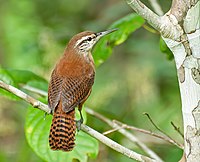
- Genus Cantorchilus (formerly included in Thryothorus)
- Cabanis's wren (Cantorchilus modestus)
- Canebrake wren (Cantorchilus zeledoni)
- Isthmian wren (Cantorchilus elutus)
- Vitrify-breasted wren (Cantorchilus leucotis) (probably not monophyletic)
- Superciliated wren (Cantorchilus superciliaris)
- Fawn-breasted wren (Cantorchilus guarayanus)
- Long-billed wren (Cantorchilus longirostris)
- Grey wren (Cantorchilus griseus)
- Riverside wren (Cantorchilus semibadius)
- Bay wren (Cantorchilus nigricapillus)
- Stripe-breasted wren (Cantorchilus thoracicus)
- Stripe-throated wren (Cantorchilus leucopogon)
- Genus Thryothorus
- Carolina wren (Thryothorus ludovicianus)
- White-browed wren (Thryothorus (ludovicianus) albinucha)
- Carolina wren (Thryothorus ludovicianus)

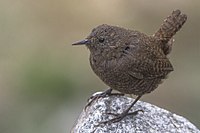
- Genus Troglodytes (10–15 species, depending on taxonomy; includes species sometimes considered to be in the genus Nannus, which may be distinct)[sixteen]
- Eurasian wren (Troglodytes troglodytes)
- Winter wren (Troglodytes hiemalis)
- Pacific wren (Troglodytes pacificus)
- Clarión wren (Troglodytes tanneri)
- Firm wren (Troglodytes aedon)
- Cobb'southward wren (Troglodytes cobbi)
- Socorro wren (Troglodytes sissonii)
- Rufous-browed wren (Troglodytes rufociliatus)
- Ochraceous wren (Troglodytes ochraceus)
- Mountain wren (Troglodytes solstitialis)
- Santa Marta wren (Troglodytes monticola)
- Tepui wren (Troglodytes rufulus)
- Genus Thryorchilus
- Timberline wren (Thryorchilus browni)
- Genus Uropsila
- White-bellied wren (Uropsila leucogastra)
- Genus Henicorhina (forest wrens)
- White-breasted wood wren (Henicorhina leucosticta)
- Greyness-breasted forest wren (Henicorhina leucophrys)
- Hermit forest wren (Henicorhina anachoreta) – separate from H. leucophrys
- Bar-winged wood wren (Henicorhina leucoptera)
- Munchique wood wren (Henicorhina negreti)
- Genus Microcerculus
- Northern nightingale-wren (Microcerculus philomela)
- Southern nightingale-wren (Microcerculus marginatus)
- Flutist wren (Microcerculus ustulatus)
- Fly-banded wren (Microcerculus bambla)
- Genus Cyphorhinus
- Anecdote-breasted wren (Cyphorhinus thoracicus)
- Musician wren (Cyphorhinus arada)
- Song wren (Cyphorhinus phaeocephalus)
Human relationship with humans [edit]
The wren features prominently in culture. The Eurasian wren has been long considered "the king of birds" in Europe.[17] Killing i or harassing its nest is associated with bad luck, such as broken bones, lightning strikes on homes, or injury to cattle. Wren Day, celebrated in parts of Ireland on St. Stephen's Twenty-four hour period (26 December), features a fake wren being paraded around town on a decorative pole; upwardly to the 20th century, existent birds were hunted for this purpose.[eighteen] A possible origin for the tradition is revenge for the betrayal of Saint Stephen by a noisy wren when he was trying to hide from enemies in a bush-league.[19]
The Carolina wren (Thryothorus ludovicianus) has been the state bird of Due south Carolina since 1948, and features on the back of its state quarter.[xx] [21] The British farthing featured a wren on the opposite side from 1937 until its demonetisation in 1960. The Cactus wren (Campylorhynchus brunneicapillus) was designated the state bird of Arizona in 1931.[22]
- The South Carolina state quarter (left) and British farthing (right) both feature wrens
-

-
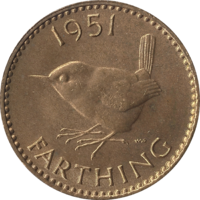
References [edit]
- ^ "21 Facts on Wren - Tweetapedia - Living with Birds". www.livingwithbirds.com . Retrieved 2020-07-17 .
- ^ a b c d east f g h i j one thousand Kroodsma, Donald; Brewer, David (2005), "Family Troglodytidae (Wrens)", in del Hoyo, Josep; Elliott, Andrew; Christie, David (eds.), Handbook of the Birds of the Earth. Book 10, Cuckoo-shrikes to Thrushes, Barcelona: Lynx Edicions, pp. 356–447, ISBN84-87334-72-5
- ^ Kluge-Lutz, English Etymology tentatively advise association with Old High German (w)renno "stallion", just Suolahti (1909) rejects this as unlikely.
- ^ "It goes by the nickname of 'old man' or 'king'; and the story goes that for this reason the eagle is at war with him." http://etext.virginia.edu/etcbin/toccer-new2?id=AriHian.xml&images=images/modeng&data=/texts/english/modeng/parsed&tag=public&part=nine&segmentation=div2
- ^ "Pliny the Elderberry, the Natural History, Book Ten. THE NATURAL HISTORY OF BIRDS., CHAP. 95. (74.)—ANTIPATHIES OF ANIMALS. PROOFS THAT THEY ARE SENSIBLE OF FRIENDSHIP AND OTHER Angel".
- ^ "The roiall Ægle hateth the Wren, and why? because (if we may beleeve information technology) he is named Regulus, [i. the petie-male monarch.]" http://penelope.uchicago.edu/holland/pliny10.html
- ^ a b Suolahti, Viktor Hugo (1909). Die deutschen Vogelnamen: eine wortgeschichtliche Untersuchung (in German). Strassbourg: Karl J Trbner. pp. eighty–85.
- ^ βασιλεύς . Liddell, Henry George; Scott, Robert; A Greek–English language Lexicon at the Perseus Project.
- ^ βασιλίσκος in Liddell and Scott.
- ^ Arnott, William Geoffrey (2007). Birds in the aboriginal world from A to Z. Abingdon: Routledge. p. 35. ISBN978-0-415-23851-9.
- ^ Cocker, Mark; Mabey, Richard (2005). Birds Britannica. London: Chatto & Windus. p. 232. ISBN978-0-7011-6907-7.
- ^ Harper, Douglas. "troglodyte". Online Etymology Dictionary.
- ^ Perrins, C. (1991). Forshaw, Joseph (ed.). Encyclopaedia of Animals: Birds. London: Merehurst Printing. p. 190. ISBN1-85391-186-0.
- ^ Oliveros, C. H.; et al. (2019). "Earth history and the passerine superradiation". Proceedings of the National Academy of Sciences of the Usa. 116 (16): 7916–7925. doi:10.1073/pnas.1813206116. PMC6475423. PMID 30936315.
- ^ Alström, Per; Ericson, Per G. P.; Olsson, Urban; Sundberg, Per (2006). "Phylogeny and nomenclature of the avian superfamily Sylvioidea". Molecular Phylogenetics and Evolution. 38 (ii): 381–97. doi:10.1016/j.ympev.2005.05.015. PMID 16054402.
- ^ Albrecht, Frederik; Hering, Jens; Fuchs, Elmar; Illera, Juan Carlos; Ihlow, Flora; Shannon, Thomas J.; Collinson, J. Martin; Wink, Michael; Martens, Jochen; Päckert, Martin (2020). "Phylogeny of the Eurasian Wren Nannus troglodytes (Aves: Passeriformes: Troglodytidae) reveals deep and complex diversification patterns of Ibero-Maghrebian and Cyrenaican populations". PLOS One. fifteen (3): e023015. Bibcode:2020PLoSO..1530151A. doi:10.1371/journal.pone.0230151. PMC7082076. PMID 32191719.
- ^ Frazer, James George (1922). "Chapter 54. Types of Animal Sacrament". The Golden Bough: A Study in Magic and Faith. New York: Macmillan.
- ^ Lawrence, Elizabeth Atwood (1997). Hunting the Wren: Transformation of Bird to Symbol: a Written report in Man-animal Relationships. Knoxville: Academy of Tennessee Printing. ISBN9780870499609.
- ^ Eveleth, Rose (26 December 2012). "The Irish Used to Celebrate The Solar day Afterwards Christmas by Killing Wrens". Smithsonian Magazine . Retrieved 27 Jan 2016.
- ^ "South Carolina State Bird – Thryrothorus ludovicianus". NetState. Retrieved 27 January 2016.
- ^ "The Official South Carolina Country Quarter". TheUS50. Retrieved 27 January 2016.
- ^ "Arizona State Bird – Campylorhynchus brunneicapillus couesi". NetState. September iii, 2017. Retrieved July 10, 2020.
- Mann, Nigel I.; Barker, F. Keith; Graves, Jeff A.; Dingess-Isle of mann, Kimberly A.; Slater, Peter J. B. (2006). "Molecular data delineate four genera of "Thryothorus" wrens". Molecular Phylogenetics and Evolution. 40 (3): 750–759. doi:x.1016/j.ympev.2006.04.014. PMID 16750640.
- Martínez Gómez, Juan Eastward.; Barber, Bruian R.; Peterson, A. Townsend (2005). "Phylogenetic position and generic placement of the Socorro Wren (Thryomanes sissonii)" (PDF). Auk. 122 (1): 50–56. doi:10.1642/0004-8038(2005)122[0050:PPAGPO]ii.0.CO;2. hdl:1808/16612. Archived from the original (PDF) on 2008-12-17. Retrieved 2007-02-22 . [English with Spanish abstract]
External links [edit]
| | Expect up wren in Wiktionary, the free dictionary. |
- Videos, photos and sounds—Net Bird Drove
Source: https://en.wikipedia.org/wiki/Wren
Posted by: perrywhearommens.blogspot.com

0 Response to "What Type Of Animal Is A Wren"
Post a Comment